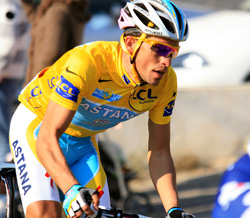 Tour de France champion Alberto Contador is clearly in strong form, having taken his third stage race victory of the season yesterday when he triumphed in the Vuelta a Castilla y León. The Astana rider is next scheduled to compete in Wednesday’s Flèche Wallonne and then Liège-Bastogne-Liège on Sunday, but his chances of performing in the first of those two events may well be compromised by the ordeal he will face to get there.
Tour de France champion Alberto Contador is clearly in strong form, having taken his third stage race victory of the season yesterday when he triumphed in the Vuelta a Castilla y León. The Astana rider is next scheduled to compete in Wednesday’s Flèche Wallonne and then Liège-Bastogne-Liège on Sunday, but his chances of performing in the first of those two events may well be compromised by the ordeal he will face to get there.
The massive atmospheric ash scatter generated by volcano Eyjafjallajökull has inconvenienced many professionals in the peloton, with large numbers being forced to travel by land prior to yesterday’s Amstel Gold Race.
The cancellation of air flights around Europe even led to some notable absentees, including Bradley Wiggins (Team Sky), Carlos Sastre (Cervélo Test Team), and one of the pre-race favourites, Alejandro Valverde (Caisse d’Epargne).
Like the latter two, Contador faces a long journey from Spain. He’s just finished a tough stage race, though, and was tied up with that until Sunday afternoon. Ideally he’d have had a chance to ease out his legs on Monday with a recovery ride, but instead he left Santiago de Compostela two hours after the podium ceremony and started the first leg of a long journey.
He travelled across the French border to Pau, where he spent last night. This morning he will take a train to Paris, and then from there he will travel by car to Liège. In all the journey will be 1900 kilometres; hardly the best preparation for a tough one-day Classic.
Still, he’s in a better position than the Team Sky rider Kurt Asle Arvesen was. He was invited by Statoil to give a talk on one of its oil rigs and travelled there last Wednesday; the subsequent ash plume from the volcano meant that he was stuck there for several days after that.
“I first realised I was stranded on Thursday morning as we were told no helicopters were flying,” he said on the Team Sky website. “They couldn’t use boats to get people on and off because the sea level was 40 metres below the platform and it was too dangerous to dock.
“I wasn’t the only one stranded either. There were a lot of people that had been there for many weeks and all they could do was wait like me, because they were not allowed to work for any longer than three-week periods.
“Thankfully they have a lot of equipment out there so it wasn’t a problem to fill my time. I kept busy by doing lots more spinning and weight training. I also got to look around the rig in a lot more detail and learn about the processes they use.”
Arvesen said that these exercises kept him in shape. He also improvised to get an additional workout.
“I went right down to the bottom of the rig, which is about 155m below sea level, and that meant I used thousands of stairs. I did that trip about 10 times so that will definitely have kept me fit,” he said.
He was able to watch the Amstel Gold race on television and to get online from the on-board computer rooms, but had no mobile phone reception for several days. The Norwegian finally got airlifted back to civilisation yesterday evening, being taken by helicopter to Bergen. From there he faced a long bus journey before he reached home.
It was undoubtedly an inconvenience, but he was able to look on the bright side and be upbeat about the experience. “I was able to train almost as well as I would have done at home so it could have been worse. It was an enjoyable few days. It was the first time I’ve ever been on an oil rig so it was interesting to see how everything works out there.”